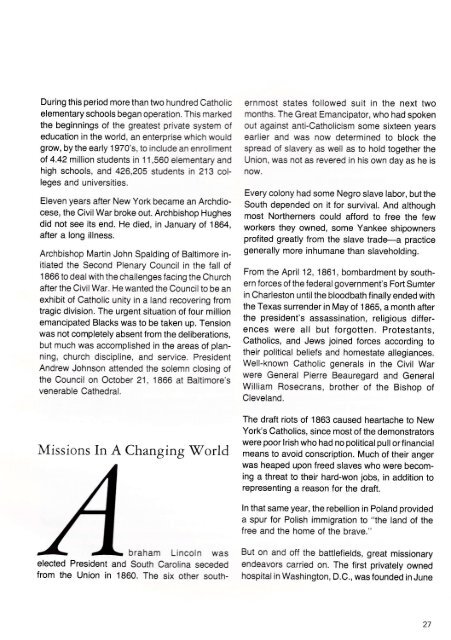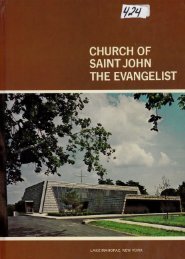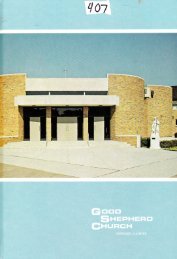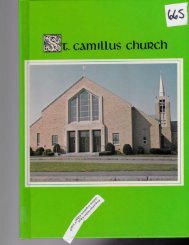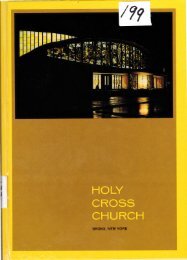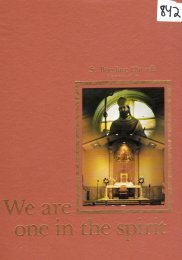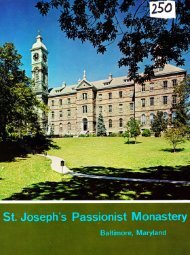Untitled - Digitizing America
Untitled - Digitizing America
Untitled - Digitizing America
Create successful ePaper yourself
Turn your PDF publications into a flip-book with our unique Google optimized e-Paper software.
During this period more than two hundred Catholic<br />
elementary schools began operation. This marked<br />
the beginnings of the greatest private system of<br />
education in the world, an enterprise which would<br />
grow, by the early 1970's, to include an enrollment<br />
of 4.42 million students in 11,560 elementary and<br />
high schools, and 426,205 students in 213 colleges<br />
and universities.<br />
Eleven years after New York became an Archdiocese,<br />
the CivilWar broke out. Archbishop Hughes<br />
did not see its end. He died, in January of 1864,<br />
after a long illness.<br />
Archbishop Martin John Spalding of Baltimore initiated<br />
the Second Plenary Council in the fall of<br />
1866 to dealwith the challenges facing the Church<br />
after the Civil War. He wanted the Council to be an<br />
exhibit of Catholic unity in a land recovering from<br />
tragic division. The urgent situation of four million<br />
emancipated Blacks was to be taken up. Tension<br />
was not completely absent from the deliberations,<br />
but much was accomplished in the areas of planning,<br />
church discipline, and seryice. President<br />
Andrew Johnson attended the solemn closing of<br />
the Council on October 21, 1866 at Baltimore's<br />
venerable Cathedral.<br />
Missions In A Changing rilTorld<br />
elected President<br />
braham Lincoln was<br />
and South Carolina seceded<br />
from the Union in 1860. The six other south-<br />
ernmost states followed suit in the next two<br />
months. The Great Emancipator, who had spoken<br />
out against anti-Catholicism some sixteen years<br />
earlier and was now determined to block the<br />
spread of slavery as well as to hold together the<br />
Union, was not as revered in his own day as he is<br />
now.<br />
Every colony had some Negro slave labor, but the<br />
South depended on it for survival. And although<br />
most Northerners could afford to free the few<br />
workers they owned, some Yankee shipowners<br />
profited greatly from the slave trade-a practice<br />
generally more inhumane than slaveholding.<br />
From the April 12, 1861, bombardment by southern<br />
forces of the federal government's Fort Sumter<br />
in Charleston untilthe bloodbath finally ended with<br />
the Texas surrender in May of 1865, a month after<br />
the president's assassination, religious differences<br />
were all but forgotten. Protestants,<br />
Catholics, and Jews joined forces according to<br />
their political beliefs and homestate allegiances.<br />
Well-known Catholic generals in the Civil War<br />
were General Pierre Beauregard and General<br />
William Rosecrans, brother of the Bishop of<br />
Cleveland.<br />
The draft riots of 1863 caused heartache to New<br />
York's Catholics, since most of the demonstrators<br />
were poor Irish who had no politicalpullorfinancial<br />
means to avoid conscription. Much of their anger<br />
was heaped upon freed slaves who were becoming<br />
a threat to their hard-won jobs, in addition to<br />
representing a reason for the draft.<br />
ln that same year, the rebellion in Poland provided<br />
a spur for Polish immigration to "the land of the<br />
free and the home of the brave."<br />
But on and off the batilefields, great missionary<br />
endeavors carried on. The first privately owned<br />
hospital in Washington, D.C., was founded in June<br />
27


